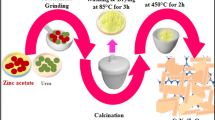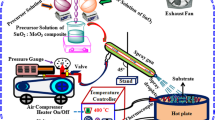Abstract
We developed an improved hexagonal wurtzite ZnO and ZnO/C microflowers through the facile hydrothermal technique. The obtained nanostructures were characterized using X-ray diffraction (XRD), Fourier transform infrared spectroscopy (FT-IR), scanning electron microscopy (SEM), Transmission electron microscopy (TEM), Energy-dispersive X-ray spectroscopy (EDX) and UV–visible diffuse reflectance spectroscopy (UV–Vis DRS). The formation of flower-like material is confirmed using SEM and TEM analysis with an average diameter of about 2 µm composed of several plate-like nanostructures. The optical analysis results show that the presence of carbon particles with ZnO structures has significantly increased the light absorption ability of nanocomposite. The photocatalytic degradation ability of prepared nanostructures was examined using methylene blue as a model pollutant. The obtained results show that the photocatalytic degradation ability of ZnO/C nanostructures is approximately two times higher than the pristine ZnO microflowers. Based on the investigation, an enhancement of the photocatalytic ability of ZnO/C nanocomposite is achieved due to the synergistic effect between carbon particles and flower-like ZnO nanostructures.













Similar content being viewed by others
References
C. Zeng, Y. Hu, H. Huang, BiOBr0.75I0.25/BiOIO3 as a novel heterojunctional photocatalyst with superior visible-light-driven photocatalytic activity in removing diverse industrial pollutants. ACS Sustain. Chem. Eng. 5, 3897–3905 (2017)
S.L. Hailu, B.U. Nair, M. Redi-Abshiro, I. Diaz, M. Tessema, Preparation and characterization of cationic surfactant modified zeolite adsorbent material for adsorption of organic and inorganic industrial pollutants. J. Environ. Chem. Eng. 5, 3319–3329 (2017)
S. Wong, N.A.N. Yac’cob, N. Ngadi, O. Hassan, I.M. Inuwa, From pollutant to solution of wastewater pollution: Synthesis of activated carbon from textile sludge for dye adsorption. Chinese J. Chem. Eng. 26, 870–878 (2018)
S. Khan, A. Malik, Toxicity evaluation of textile effluents and role of native soil bacterium in biodegradation of a textile dye. Environ. Sci. Poll. Res. 25, 4446–4458 (2018)
D. Santos, C. Carvalho, R. Mouta, M.C.C. Junior, S.A.A. Santana, H.A. dos Santos Silva, C.W.B. Bezerra, Chitosan-edible oil based materials as upgraded adsorbents for textile dyes. Carbohydr. Polym. 180, 182–191 (2018)
D. Cheng, H.H. Ngo, W. Guo, S.W. Chang, D.D. Nguyen, Y. Liu, Q. Wei, D. Wei, A critical review on antibiotics and hormones in swine wastewater: Water pollution problems and control approaches. J. Hazard. Mater. 387, 121682 (2020)
I.A. Wright, K. Paciuszkiewicz, N. Belmer, Increased water pollution after closure of Australia’s longest operating underground coal mine: a 13-month study of mine drainage, water chemistry and river ecology. Water, Air, Soil Pollut. 229, 1–20 (2018)
I. Mantasha, S. Hussain, M, Ahmad, M. Shahid, Two dimensional (2D) molecular frameworks for rapid and selective adsorption of hazardous aromatic dyes from aqueous phase. Sep. Purif. Technol. 238, 116413 (2020)
C. Liu, L.-Q. Yu, Y.-T. Zhao, Y.-K. Lv, Recent advances in metal-organic frameworks for adsorption of common aromatic pollutants. Microchim. Acta 185, 1–12 (2018)
Y. Shen, C. Zhu, S. Song, T. Zeng, L. Li, Z. Cai, Defect-abundant covalent triazine frameworks as sunlight-driven self-cleaning adsorbents for volatile aromatic pollutants in water. Environ. Sci. Technol. 53, 9091–9101 (2019)
S. Abbasi, M. Hasanpour, M.-S. Ekrami-Kakhki, Removal efficiency optimization of organic pollutant (methylene blue) with modified multi-walled carbon nanotubes using design of experiments (DOE). J. Mater. Sci.: Mater Electron. 28, 9900–9910 (2017)
M. Kamaraj, N.R. Srinivasan, G. Assefa, A.T. Adugna, M. Kebede, Facile development of sunlit ZnO nanoparticles-activated carbon hybrid from pernicious weed as an operative nano-adsorbent for removal of methylene blue and chromium from aqueous solution: extended application in tannery industrial wastewater. Environ. Technol. Innov. 17, 100540 (2020)
A. Lee, M.S. Liew, Tertiary recycling of plastics waste: an analysis of feedstock, chemical and biological degradation methods. J. Mater. Cycles Waste Manag. 23, 32–43 (2021)
X.W. Wang, L. Lu, C. Zhou, Z. Xin, J. Wang, X. Ke, G.B. Sheng, S. Yan, Z. Zou, Oxygen-vacancy-activated CO2 splitting over amorphous oxide semiconductor photocatalyst. ACS Catal. 8, 516–525 (2018)
Y. Zhao, R. Li, L. Mu, C. Li, Significance of crystal morphology controlling in semiconductor-based photocatalysis: a case study on BiVO4 photocatalyst. Cryst. Growth Des. 17, 2923–2928 (2017)
Q. Lei, S. Yang, D. Ding, J. Tan, J. Liu, R. Chen, Local-interaction-field-coupled semiconductor photocatalysis: recent progress and future challenges. J. Mater. Chem. A 9, 2491–2525 (2021)
Z. Mirzaeifard, Z. Shariatinia, M. Jourshabani, S.M.R. Darvishi, ZnO photocatalyst revisited: Effective photocatalytic degradation of emerging contaminants using S-doped ZnO nanoparticles under visible light radiation. Ind. Eng. Chem. Res. 59, 15894–15911 (2020)
D. Kim, K. Yong, Boron doping induced charge transfer switching of a C3N4/ZnO photocatalyst from Z-scheme to type II to enhance photocatalytic hydrogen production. Appl. Catal. B: Environ. 282, 119538 (2021)
M.M. Obeid, C. Stampfl, A. Bafekry, Z. Guan, H.R. Jappor, C.V. Nguyen, M. Naseri et al., First-principles investigation of nonmetal doped single-layer BiOBr as a potential photocatalyst with a low recombination rate. Phy. Chem. Chem. Phy. 22, 15354–15364 (2020)
S. Shanavas, S.M. Roopan, A. Priyadharsan, D. Devipriya, S. Jayapandi, R. Acevedo, P.M. Anbarasan, Computationally guided synthesis of (2D/3D/2D) rGO/Fe2O3/g-C3N4 nanostructure with improved charge separation and transportation efficiency for degradation of pharmaceutical molecules. Appl. Catal. B: Environ. 255, 117758 (2019)
J. Lu, M. Jiang, M. Wei, C. Xu, S. Wang, Z. Zhu, F. Qin, Z. Shi, C. Pan, Plasmon-induced accelerated exciton recombination dynamics in ZnO/Ag hybrid nanolasers. ACS Photonics 4, 2419–2424 (2017)
F. Zhang, Y.-H. Li, M.-Y. Qi, Z.-R. Tang, Y.-J. Xu, Boosting the activity and stability of Ag-Cu2O/ZnO nanorods for photocatalytic CO2 reduction. Appl. Catal. B: Environ. 268, 118380 (2020)
M. Pirhashemi, A. Habibi-Yangjeh, S.R. Pouran, Review on the criteria anticipated for the fabrication of highly efficient ZnO-based visible-light-driven photocatalysts. J. Ind. Eng. Chem. 62, 1–25 (2018)
I.J. Ani, U.G. Akpan, M.A. Olutoye, B.H. Hameed, Photocatalytic degradation of pollutants in petroleum refinery wastewater by TiO2-and ZnO-based photocatalysts: recent development. J. Clean. Prod. 205, 930–954 (2018)
A. Serrà, Y. Zhang, B. Sepúlveda, E. Gomez, J. Nogués, J. Michler, L. Philippe, Highly reduced ecotoxicity of ZnO-based micro/nanostructures on aquatic biota: Influence of architecture, chemical composition, fixation, and photocatalytic efficiency. Water Res. 169, 115210 (2020)
H. Wang, X. Qiu, W. Liu, D. Yang, Facile preparation of well-combined lignin-based carbon/ZnO hybrid composite with excellent photocatalytic activity. Appl. Surf. Sci. 426, 206–216 (2017)
V. Hasija, A. Sudhaik, P. Raizada, A. Hosseini-Bandegharaei, P. Singh, Carbon quantum dots supported AgI/ZnO/phosphorus doped graphitic carbon nitride as Z-scheme photocatalyst for efficient photodegradation of 2, 4-dinitrophenol. J. Environ. Chem. Eng. 7, 103272 (2019)
S.A. Ansari, S.G. Ansari, H. Foaud, M.H. Cho, Facile and sustainable synthesis of carbon-doped ZnO nanostructures towards the superior visible light photocatalytic performance. New J. Chem. 41, 9314–9320 (2017)
W. Zou, B. Gao, Y.S. Ok, L. Dong, Integrated adsorption and photocatalytic degradation of volatile organic compounds (VOCs) using carbon-based nanocomposites: A critical review. Chemosphere 218, 845–859 (2019)
B. Dang, Q. Li, Y. Zhou, J. Hu, J. He, Suppression of elevated temperature space charge accumulation in polypropylene/elastomer blends by deep traps induced by surface-modified ZnO nanoparticles. Compos. Sci. Technol. 153, 103–110 (2017)
C. Lops, A. Ancona, K.D. Cesare, B. Dumontel, N. Garino, G. Canavese, S. Hérnandez, V. Cauda, Sonophotocatalytic degradation mechanisms of Rhodamine B dye via radicals generation by micro-and nano-particles of ZnO. Appl. Catal. B: Environ. 243, 629–640 (2019)
S. Sultana, S. Mansingh, K.M. Parida, Facile synthesis of CeO2 nanosheets decorated upon BiOI microplate: A surface oxygen vacancy promoted z-scheme-based 2D–2D nanocomposite photocatalyst with enhanced photocatalytic activity. J. Phy. Chem. C 122, 808–819 (2018)
Y. Xu, H. Li, B. Sun, P. Qiao, L. Ren, G. Tian, B. Jiang, K. Pan, W. Zhou, Surface oxygen vacancy defect-promoted electron-hole separation for porous defective ZnO hexagonal plates and enhanced solar-driven photocatalytic performance. Chem. Eng. J. 379, 122295 (2020)
S. Shanavas, A. Priyadharsan, E.I. Gkanas, R. Acevedo, P.M. Anbarasan, High efficient catalytic degradation of tetracycline and ibuprofen using visible light driven novel Cu/Bi2Ti2O7/rGO nanocomposite: kinetics, intermediates and mechanism. J. Ind. Eng. Chem. 72, 512–528 (2019)
Y. Liu, D. Huang, H. Liu, T. Li, J. Wang, ZnO tetrakaidecahedrons with coexposed 001},{101}, and {100 facets: Shape-selective synthesis and enhancing photocatalytic performance. Cryst. Growth Des. 19, 2758–2764 (2019)
V.Y. Zenou, Bakardjieva, Microstructural analysis of undoped and moderately Sc-doped TiO2 anatase nanoparticles using Scherrer equation and Debye function analysis. Mater. Charact. 144, 287–296 (2018)
H. Liang, X. Tai, Z. Du, Y. Yin, Enhanced photocatalytic activity of ZnO sensitized by carbon quantum dots and application in phenol wastewater Opt. Mater. 100, 109674 (2020)
N. Nasseh, F.S. Arghavan, S. Rodriguez-Couto, A.H. Panahi, M. Esmati, T.J. A-Musawi, Preparation of activated carbon@ ZnO composite and its application as a novel catalyst in catalytic ozonation process for metronidazole degradation. Adv. Powder Technol. 31, 875–885 (2020)
D. Balram, K.-Y. Lian, N. Sebastian, Synthesis of a functionalized multi-walled carbon nanotube decorated ruskin michelle-like ZnO nanocomposite and its application in the development of a highly sensitive hydroquinone sensor. Inorg. Chem. Front. 5, 1950–1961 (2018)
W. Jia, B. Jia, F. Qu, X. Wu, Towards a highly efficient simulated sunlight driven photocatalyst: a case of heterostructured ZnO/ZnS hybrid structure. Dalton Trans. 42, 14178–14187 (2013)
L. Miao, B. Shi, S. Nawrat, Mu. Chaomin, K. Qi, Facile synthesis of hierarchical ZnO microstructures with enhanced photocatalytic activity. Mater. Sci. Poland 35, 45–49 (2017)
C. Xu, Y. Wang, H. Chen, Rapid and simple synthesis of 3D ZnO microflowers at room temperature. Mater. Lett. 158, 347–350 (2015)
F. Liao, X. Han, Y. Zhang, C. Xu, H. Chen, Hydrothermal synthesis of flower-like zinc oxide microstructures with large specific surface area, J. Mater. Sci.: Mater. Electron. 28, 16855–16860 (2017)
L. Fang, B. Zhang, W. Li, J. Zhang, K. Huang, Q. Zhang, Fabrication of highly dispersed ZnO nanoparticles embedded in graphene nanosheets for high performance supercapacitors. Electrochim. Acta 148, 164–169 (2014)
J. Xue, S. Ma, Y. Zhou, Z. Zhang, Facile synthesis of ZnO–C nanocomposites with enhanced photocatalytic activity. New J. Chem. 39, 1852–1857 (2015)
C. Sasirekha, S. Arumugam, G. Muralidharan, Green synthesis of ZnO/carbon (ZnO/C) as an electrode material for symmetric supercapacitor devices. Appl. Surf. Sci. 449, 521–527 (2018)
H. Osman, Z. Su, X. Ma, S. Liu, X. Liu, D. Abduwayit, Synthesis of ZnO/C nanocomposites with enhanced visible light photocatalytic activity. Ceram. Int. 42, 10237–10241 (2016)
C. Yang, X. Wang, Y. Ji, T. Ma, F. Zhang, Y. Wang, M. Ci, D. Chen, A. Jiang, W. Wang, Photocatalytic degradation of methylene blue with ZnO@C nanocomposites: Kinetics, mechanism, and the inhibition effect on monoamine oxidase A and B. NanoImpact 15, 100174 (2019)
N.M. Denisov, E.B. Chubenko, V.P. Bondarenko, V.E. Borisenko, Black ZnO/C nanocomposite photocatalytic films formed by one-step sol–gel technique. J. Sol-Gel Sci. Technol. 85, 413–420 (2018)
S. Shajahan, P. Arumugam, R. Rajendran, P.M. Anbarasan, Optimization and detailed stability study on Pb doped ceria nanocubes for enhanced photodegradation of several anionic and cationic organic pollutants. Arabian J. Chem. 13, 1309–1322 (2020)
Author information
Authors and Affiliations
Corresponding authors
Ethics declarations
Conflict of interest
Authors declare no conflict of interest.
Additional information
Publisher's Note
Springer Nature remains neutral with regard to jurisdictional claims in published maps and institutional affiliations.
Rights and permissions
About this article
Cite this article
Shibu, M.C., Benoy, M.D., Shanavas, S. et al. Hydrothermal synthesis of ZnO/C microflowers for photocatalytic degradation of organic pollutants under visible light irradiation: kinetics, mechanism and recyclability. J Mater Sci: Mater Electron 33, 9412–9424 (2022). https://doi.org/10.1007/s10854-021-07375-3
Received:
Accepted:
Published:
Issue Date:
DOI: https://doi.org/10.1007/s10854-021-07375-3




